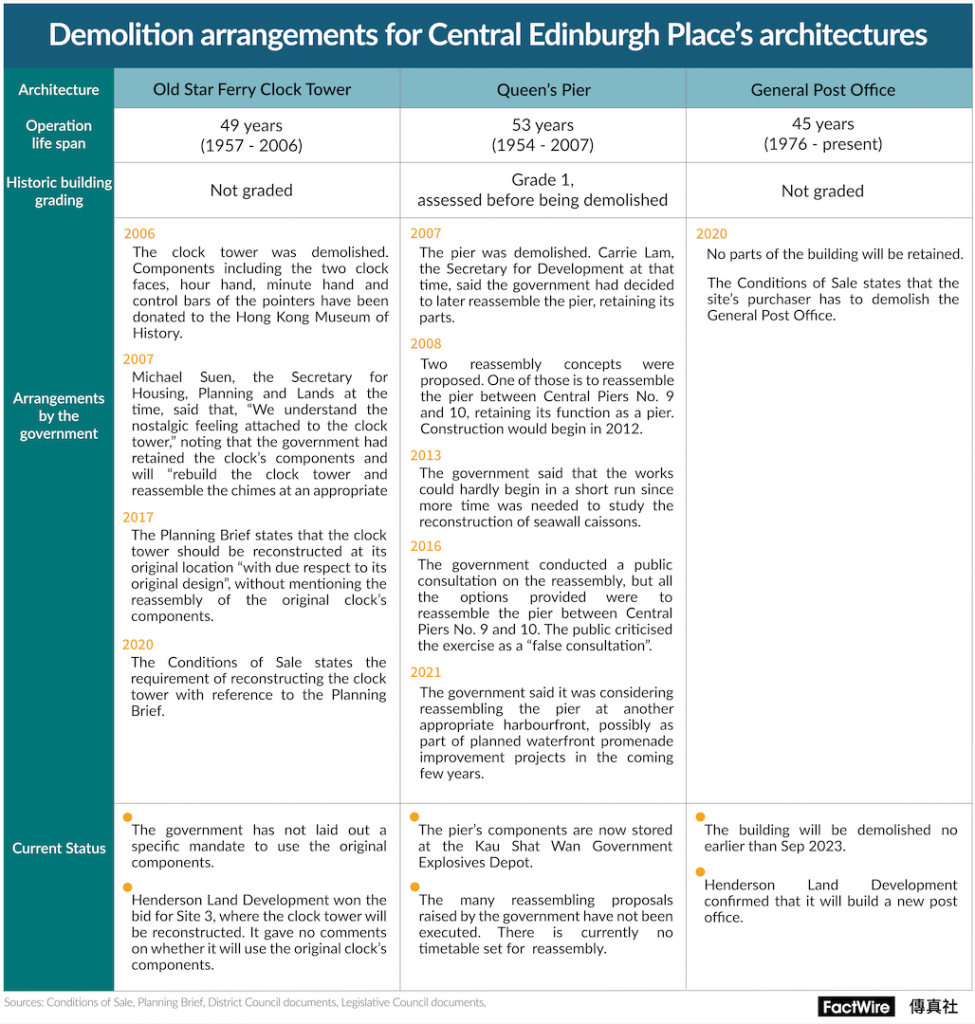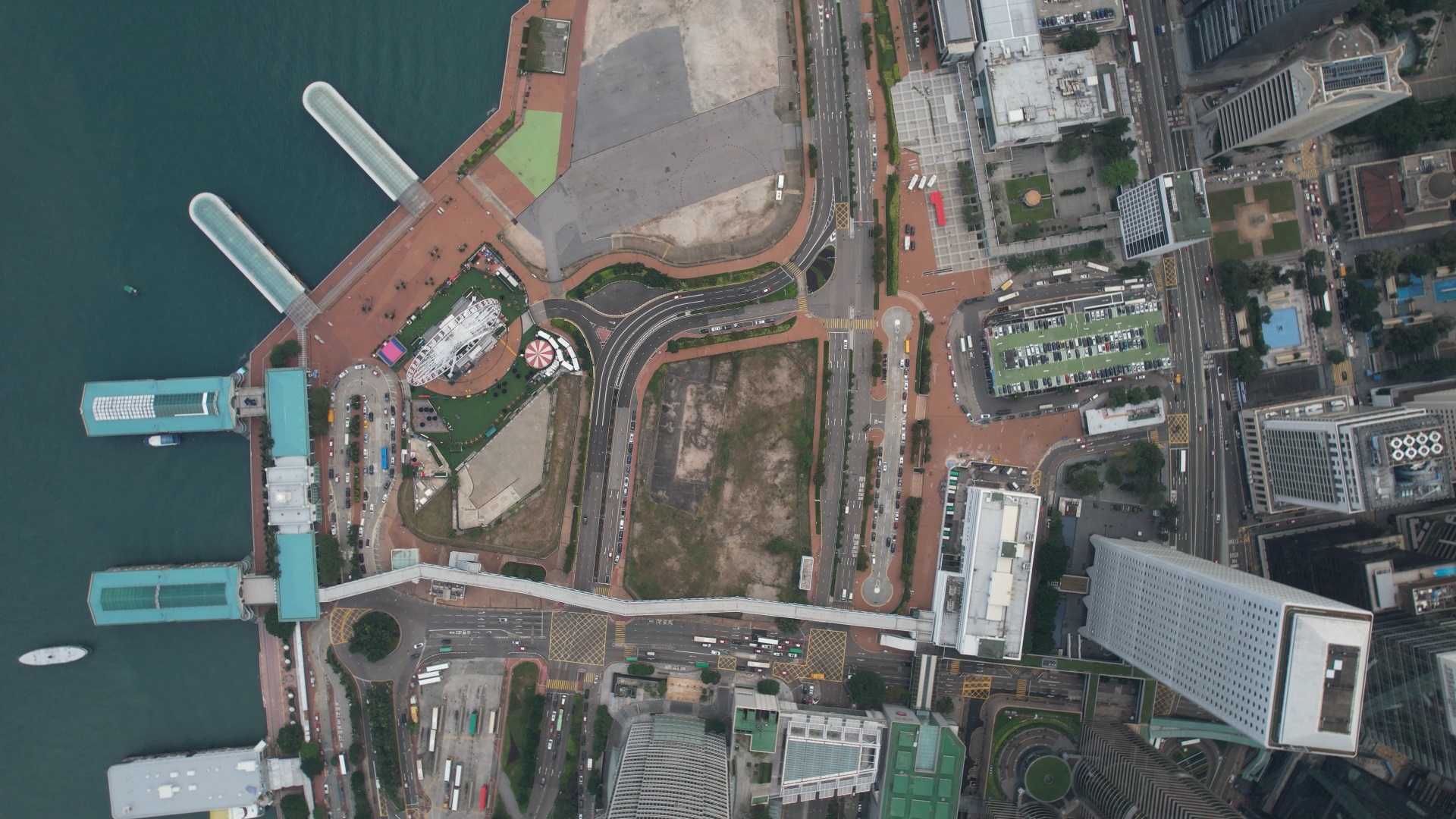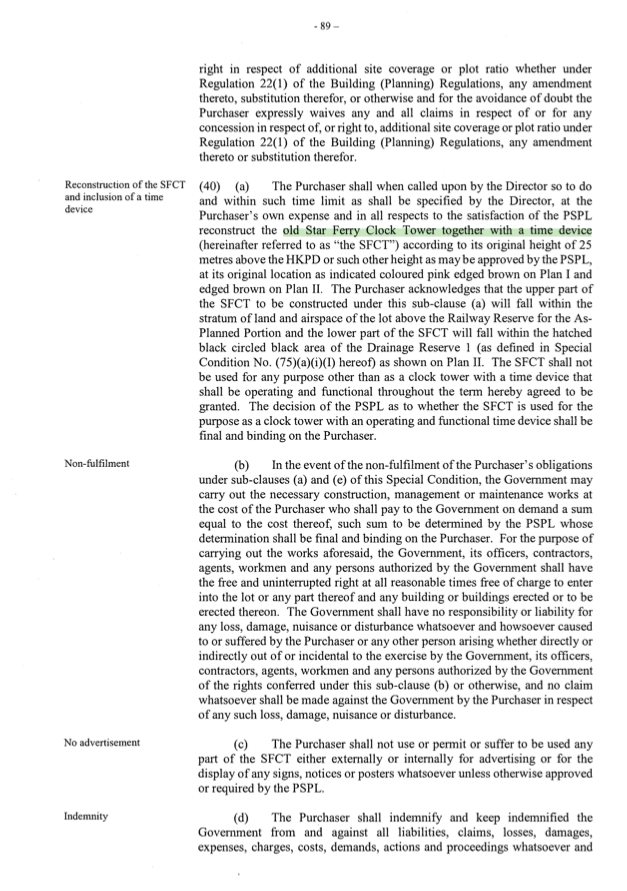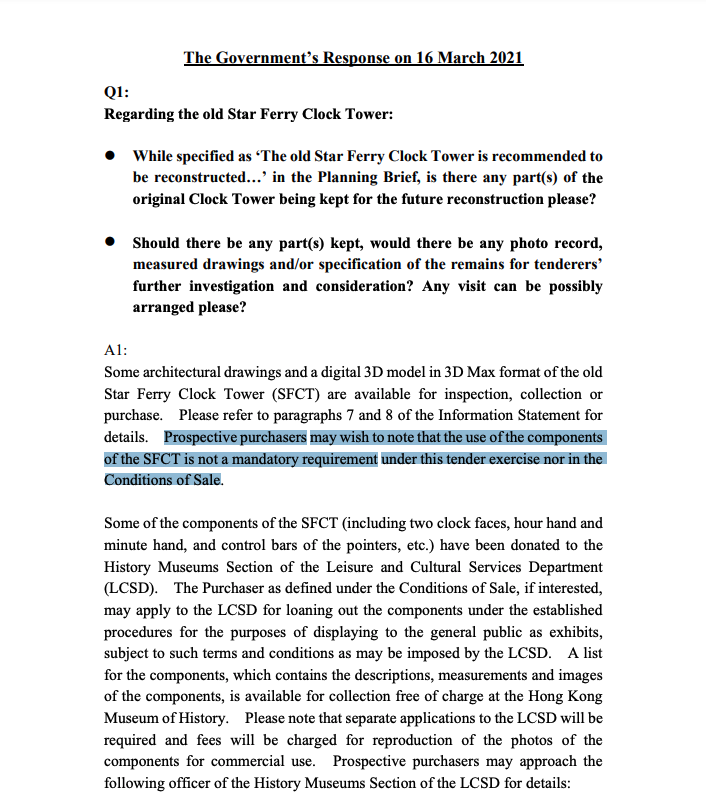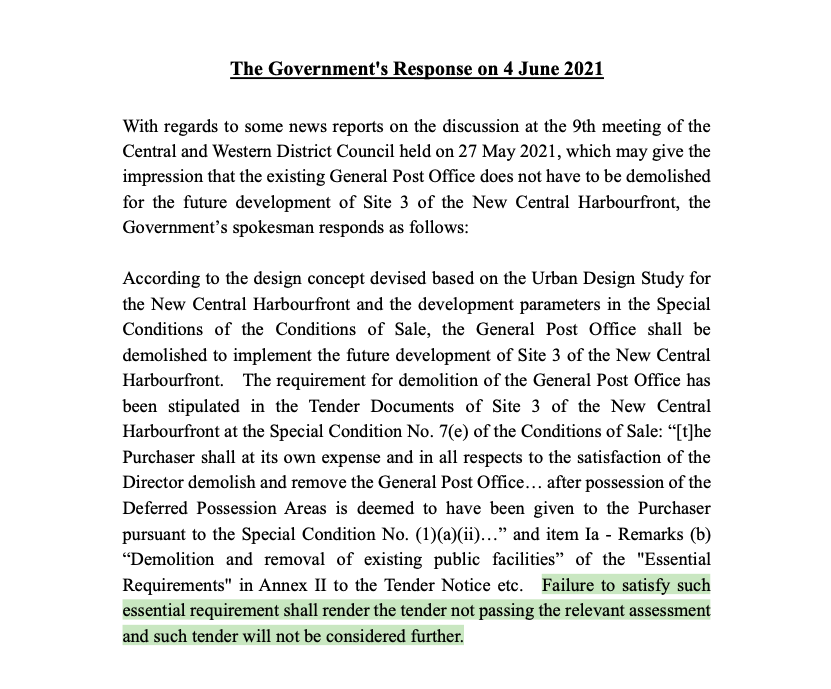Set to be rebuilt close to its original position in Central, the old Star Ferry Clock Tower may end up looking quite different from the original, demolished 15 years ago. The government clarified that under the tender exercise, the use of the original clock’s components is not mandatory.
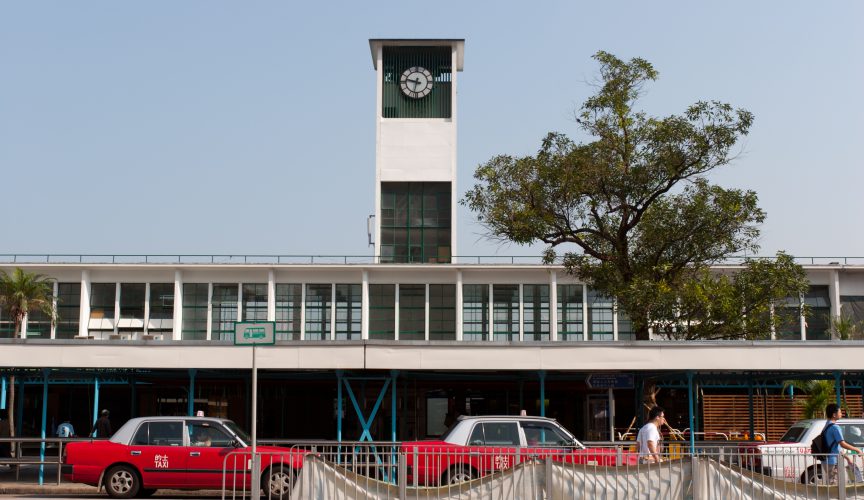
Set to be rebuilt close to its original position in Central, the old Star Ferry Clock Tower may end up looking quite different from the original, demolished 15 years ago. According to the concerned site’s tender awarded to Henderson Land Development last week, the government did not specify the use of the original clock, chimes and other features for the reconstructed clock tower, only requiring the land purchaser to build a 25-metre-tall tower with a “time device”. The government clarified in another document that under the tender exercise, the use of the original clock’s components is not mandatory.
FactWire’s enquiries to the Development Bureau and Henderson Land Development concerning the design and use of materials for the reconstruction of the old Star Ferry Clock Tower was met only with a response from the government saying the tower should be reconstructed “with due respect to its original design”. Henderson Land Development did not specify whether it will be using the original clock’s components.
The old Star Ferry Clock Tower was demolished in 2006 for the Central Reclamation Project. The piece of land it sat on, along with the newly-reclaimed land from the CRP, now forms Site 3 of the New Central Harbourfront – the last mega commercial plot in Central District. It was sold to Henderson Land Development at a record-setting price of HKD 50.8 billion.
The site is 516,316 square feet in size where a gross floor area of 16.15 million square feet may be developed for commercial and retail purposes.
Henderson Land Development has said it will invest HKD 63 billion to develop the site, reconstructing the old Star Ferry Clock Tower along with a new associated public square. The development project is divided into two phases, set to be completed by 2027 and 2032 respectively.
The reconstruction of the old Star Ferry Clock Tower is mandated in the land’s Conditions of Sale, which requires the purchaser to reconstruct a tower with a “time device”, at the tower’s original height of 25 metres. The reconstructed clock tower cannot be used for advertising unless approved by the government.
“The [old Star Ferry Clock Tower] shall be reconstructed with due respect to its original design,” reads the Conditions of Sale, without clearly specifying whether the original clock, chimes, material and colour of the clock tower will be preserved.
Part of the clock’s components, including the two clock faces, hour hand, minute hand, and the control bars of the pointers were donated to the History Museums Section of the Leisure and Cultural Services Department. The land purchaser may apply for a loan of the components for the purpose of public display, although the use of them is not mandated under the tender exercise for Site 3, according to the Lands Department’s open response to an enquiry in March this year.
The response also says that some architectural drawings and a digital 3D model of the clock tower are available for prospective land purchasers’ reference.
The old Star Ferry Clock Tower stood at Victoria Harbour for 49 years before being demolished in 2006. The announcement to remove the iconic clock tower brought about an outcry of protests and hunger strikes, demanding that the government take steps to preserve the architecture.
The government insisted on its plan even though community groups at that time were eager to purchase the tower at their own expense. Despite both the pan-democratic and pro-establishment camps requesting a suspension of the demolition works, the government took down the clock tower, by force, at midnight of December 16, 2006.
“The Star Ferry Pier is neither a declared monument nor a graded historical building on the basis of its heritage value. As such, it would not be preserved in-situ,” said Patrick Ho, the Secretary for Home Affairs at that time.
Two days following the demolition of the clock tower, Neil Brennan Wright of Thwaites & Reed, the clockmaker’s company which maintained Britain’s Big Ben, was invited to a Legislative Council panel meeting in Hong Kong. He said that restoring the old Star Ferry Clock Tower for future use would not be a problem.
“The clock is 99.9% complete and is a high quality clock. It can work perfectly well if restored properly, and it can continue to run for [another] 200 or 300 years,” he commented after another inspection of the clock’s components that followed the meeting.
Wright added that the clock, made by famous clockmaker Dent in the 1950s, was a high quality three-legged electro-mechanical gravity clock, with a cast-iron frame, bronze wheels, and high
quality stainless steel spindles. The clock, made specifically for the Star Ferry Pier, was “unique and valuable” as it was the second one of its kind he had seen in the past eight years.
“We understand the nostalgic feeling attached to the clock tower,” said Michael Suen, the Secretary for Housing, Planning and Lands at that time, in a written statement issued in January 2007, adding that the government had retained the clock’s components and will “rebuild the clock tower and reassemble the chimes at an appropriate location.”
The Planning Department also said in May 2007 that the clock faces, chimes and mechanical parts of the original clock will be reassembled in the reconstructed clock tower.
Ten years on, the requirement of reconstructing the old Star Ferry Clock Tower is stipulated in a much more general way, in the Planning Brief for Site 3 of the New Central Harbourfront issued in 2017, stating that the tower should be constructed at its original location “with due respect to its original design”. The use of the original clock’s components, design and material is not mentioned in the document.
In response to FactWire’s inquiry concerning the required design, use of material and other features of the reconstructed old Star Ferry Clock Tower, the Development Bureau said the relevant requirements have been stated in Site 3’s Conditions of Sale and Planning Brief. The department only restated that the clock tower should be reconstructed “with due respect to its original design”, adding that the developer may, under certain conditions, apply to loan out components of the original clock tower for public display.
Henderson Land Development asked FactWire to refer to its press releases and online press conference without providing additional comments about how it will reconstruct the clock tower. According to the developer’s design proposal, posted by the Information Services Department, a structure which looks similar to the old Star Ferry Clock Tower is included.
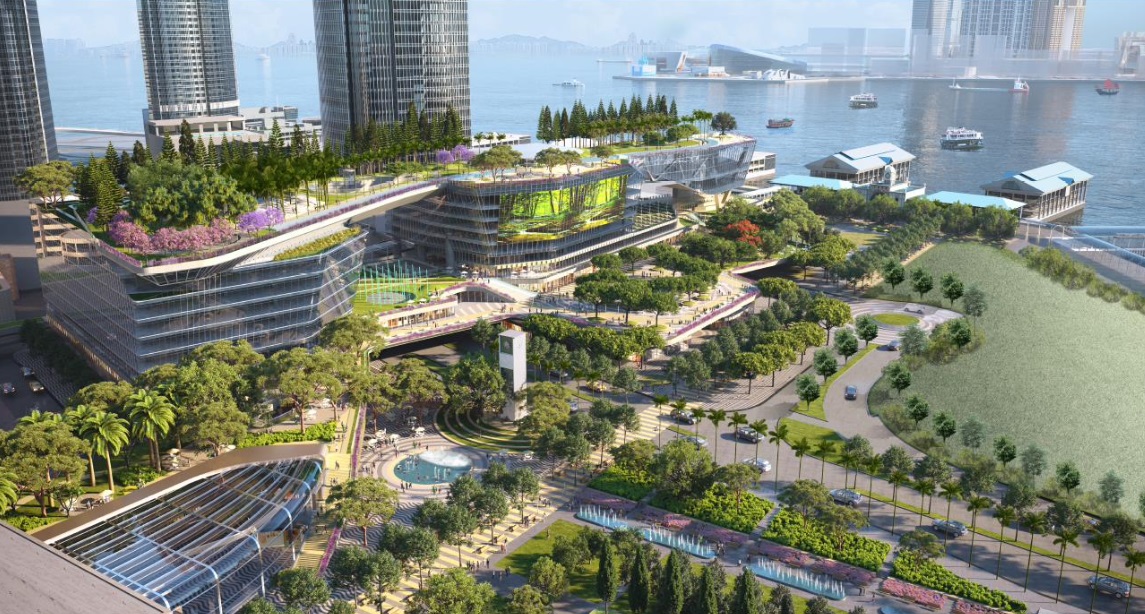

Apart from reconstructing the old Star Ferry Clock Tower, the Conditions of Sale states that the purchaser of Site 3 is required to demolish the General Post Office no earlier than September 30, 2023. Meanwhile, the purchaser must build a new district-tied post office at its own expense while the headquarters of Hongkong Post is moved to Kowloon Bay.
At a District Council meeting on May 27 this year, community architectural groups proposed a revitalisation of the General Post Office site that would have seen it converted into a museum for public use. The government quickly issued a response on June 4 to reinstate the requirement for demolition of the post office under Site 3’s tender exercise. “Failure to satisfy such essential requirement shall render the tender not passing the relevant assessment and such [a] tender will not be considered further [sic],” reads the response statement.
Henderson Land Development confirmed in a press conference that it will build a new Central Post Office at the central portion of Site 3.
The General Post Office is yet to be graded as a historic building. When asked if the Antiquities Advisory Board has plans to assess the General Post Office, the chairman of the board Douglas Cheung said on June 10 this year that the members of the board have agreed to defer the grading assessment of post-1970 buildings for now due to their heavy workload. Records show that this was a decision made at a board meeting on September 10, 2013.
Speaking with FactWire, Liber Research Community member Chan Kim-ching thinks the progress of historic building grading in Hong Kong is undesirable. He believes the government currently adopts a brief standard to include buildings aged 50 or above into the assessment list, for which the list is reviewed just once a decade. Thus, the government may wish to demolish buildings before they reach 50 years of age, in order to avoid conservational constraints once the building is graded.
Demolishment of the General Post Office was also brought up at a Legislative Council meeting in 2018. “The building design life is normally around 50 years, while the existing [General Post Office] building has been in operation for about 42 years,” said the government in a written response to the legislators at that time, “for buildings over 50 years, more resources have to be put in to upkeep its standard to a certain level.”
